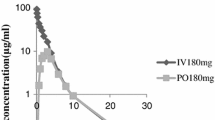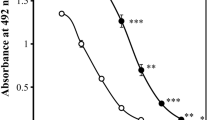Abstract
Cefotiam (CGP 14221/E; SCE 963), a semisynthetic cephalosporin, was administered as a single dose by i.v. injection to rats (up to 1.8 g/kg body-weight) and rabbits (up to 1.7 g/kg body-weight). Cephaloridine served as positive control (1.0 and 0.75 g/kg in rats; 0.3 and 0.28 g/kg in rabbits). The animals were sacrificed 24 h after injection and the kidneys preserved for routine histology and enzyme histochemistry (alkaline phosphatase, aminopeptidase, succinate dehydrogenase, esterase). Serum samples (Na+, K+, Cl−, urea, creatinine, LDH, alkaline phosphatase) and 24-h urine (Na+, K+, Cl−, urea, creatinine, protein, LDH, aminopeptidase) were analysed before and 24 h after injection.
Minimal, irregularly scattered, degenerative changes in the proximal tubules which were not dose-dependent in degree were observed in rat kidneys following cefotiam injection. A slight dose-dependent degeneration in up to 50% of proximal tubular cells with loss of brush-border membrane enzyme activity was observed in rabbit kidneys. In both animal species the ability to concentrate urine was retained and urea and creatinine serum levels hardly affected. Following cefotiam injection a dose-dependent 4-fold excretion of urinary protein but not of LDH was observed in rabbits only. By contrast, cephaloridine caused extensive degeneration and necrosis in up to 90% of proximal tubular cells in both rats and rabbits, which was accompanied with formation of enzymically active hyaline casts, loss of urine-concentrating capacity of the kidney, elevated serum levels of urea and creatinine and an increased urinary excretion of LDH (60-fold in rats, 20-fold in rabbits) and protein (3-fold in rats, 10-fold in rabbits). Histochemistry and electron microscopy of rabbit kidneys suggested a loss of microvilli from proximal tubule cells by endocytosis and thus degeneration following injection of large doses of cefotiam, whereas cell disruption and necrosis prevailed after cephaloridine. The action of cefotiam on the proximal tubule cells is, therefore, not only quantitatively but possibly also qualitatively different from that of cephaloridine.
Semiquantitative evaluation of tubular injuries in alkaline phosphatase-stained kidney sections and measurement of LDH and protein content in 24-h urine samples were advantageous in determining the quantity and the quality of nephrotoxic effects.
Similar content being viewed by others
References
Appel GB, Neu HC (1977) The nephrotoxicity of antimicrobial agents. N Engl J Med 296: 663–670, 722–728, 784–787
Barza M (1978) The nephrotoxicity of cephalosporins: An overview. J Infect Dis [Suppl] 137: 60–73
Cottrell RC, Agrelo CE, Gangolli SD, Grasso P (1976) Histochemical and biochemical studies of chemically induced acute kidney damage in the rat. Fd Cosmet Toxicol 14: 593–598
Currie GA, Little PJ, McDonald SJ (1966) The localisation of cephaloridine and nitrofurantoin in the kidney. Nephron 3: 282–288
Hoigné R (1975) Penicillins, cephalosporins and tetracyclines. In: Side effects of drugs, vol 8. Excerpta Medica, Amsterdam, pp 551–602
Hugon J, Borgers M (1966) A direct lead method for the electron microscopic visualization of alkaline-phosphatase activity. J Histochem Cytochem 14: 429–431
Ishigami J, Mita T, Momose S, Kumazawa J (1980) Clinical evaluation of cefotiam in complicated urinary tract infections: a comparative study with cefazolin by randomized double-blind method. In: Nelson JD, Grassi C (eds) Current chemotherapy and infectious disease, vol I. American Soc of Microbiology, Washington DC, pp 218–220
Manten A (1972) Antibiotic drugs. In: Side effects of drugs, vol 7. Excerpta Medica, Amsterdam, pp 335–403
Pearse AGE (1972a) Applied esterase histochemistry. In: Histochemistry, theoretical and applied, vol 2. Churchill Livingstone, Edinburgh, London, pp 799–807
Pearse AGE (1972b) Oxidoreductases I. In: Histochemistry, theoretical and applied, vol 2. Churchill Livingstone, Edinburgh, London, pp 841–879
Silverblatt F, Turck M, Bulger R (1970) Nephrotoxicity due to cephaloridine: A light and electron microscopic study in rabbits. J Infect Dis 122: 33–44
Spurr AR (1969) A low viscosity epoxy resin embedding medium for electron microscopy. J Ultrastruct Res 26: 31–43
Stroo WE, Hook JB (1977) Enzymes of renal origin in urine as indicators of nephrotoxicity. Toxicol Appl Pharmacol 39: 423–434
Tanayama S, Kondo T, Kanai Y (1978) Metabolic fate of SCE-963, a new broad spectrum cephalosporin, after parenteral administration in rats and dogs. J Antibiot 31: 703–711
Terhorst B, Lymberopoulos S, Buss H (1971) Tierexperimentelle und klinische Untersuchungen zur Frage der Nephrotoxizität von Cephaloridin. Med Welt 22: 1565–1569
Tsuchiya K, Kida M, Kondo M, Ono H, Takeuchi M, Nishi T (1978) SCE-963, a new broad spectrum cephalosporin: in vitro and in vivo antibacterial activities. Antimicrob Agents and Chemother 14: 557–568
Tune BM (1975) Relationship between the transport and toxicity of cephalosporins in the kidney. J Infect Dis 132: 189–194
Tune BM, Fernholt M, Schwartz A (1974) Mechanism of cephaloridine transport in the kidney. J Pharmacol Exp Ther 191: 311–317
Tune BM, Wu KY, Kempson RL (1977) Inhibition of transport and prevention of toxicity of cephaloridine in the kidney. Dose-responsiveness of the rabbit and the guinea pig to probenecid. J Pharmacol Exp Ther 202: 466–471
Van Klingeren B (1977) Penicillins, cephalosporins and tetracyclines. In: Side effects of drugs annual, vol 1. Excerpta Medica, Amsterdam, pp 197–205
Wachsmuth ED (1976) Aspects of regulation in kidney at the enzymic level: aldolase isozymes, aminopeptidase and alkaline phosphatase. In: Schmidt U, Dubach UC (eds) Renal metabolism in relation to renal function. Hans Huber Publishers, Bern, p 381–391
Wachsmuth ED (1981a) Quantification of nephrotoxicity in rabbits by automated morphometry of alkaline phosphatase stained kidney sections. Histochemistry 71: 235–248
Wachsmuth ED (1981b) Quantification of acute cephaloridine nephrotoxicity in rats: Correlation of serum and 24-h urine analyses with proximal tubule injuries. M.S. submitted for publication
Wachsmuth ED, Stoye JP (1976) The differentiation of proximal and distal tubules in the male rat kidney: The appearance of aldolase isozymes, aminopeptidase and alkaline phosphatase during ontogeny. Histochemistry 47: 315–337
Wachsmuth ED, Wirz H (1979) Relevance of enzyme evaluations in 24 h urine of rat-kidney injury caused by i.v. cephaloridine injection. In: Schmidt U, Dubach UC (eds) Diagnostic significance of enzymes and proteins in urine. Hans Huber Publishers, Bern, pp 88–104
Wellwood JM, Lovell D, Thompson AE, Tighe JR (1976) Renal damage caused by gentamicin: A study of the effects on renal morphology and urinary enzyme excretion. J Pathol 118: 171–182
Zak O, Konopka EA, Tosch W, Zimmermann W, Kunz S, Fehlmann H, Kradolfer F (1980) Experimental studies of cefotiam (CGP 14221/E). In: Nelson JD, Grassi C (eds) Current chemotherapy and infectious disease, vol I. American Soc of Microbiol, Washington DC, pp 223–225
Zak O, Tosch W, Kradolfer F, Konopka EA (1981) Experimental evaluation of cefotiam. Drugs Exp Clin Res 7 (in press)
Zekert F, Mautner-Markhof C (1976) Untersuchungen über die normale Enzymausscheidung im Harn des Menschen und der Ratte. Wien Klin Wschr 88: 467–469
Author information
Authors and Affiliations
Rights and permissions
About this article
Cite this article
Wachsmuth, E.D. Nephrotoxicity of cefotiam (CGP 14221/E) in rats and rabbits. Arch Toxicol 48, 135–156 (1981). https://doi.org/10.1007/BF00310483
Received:
Issue Date:
DOI: https://doi.org/10.1007/BF00310483




